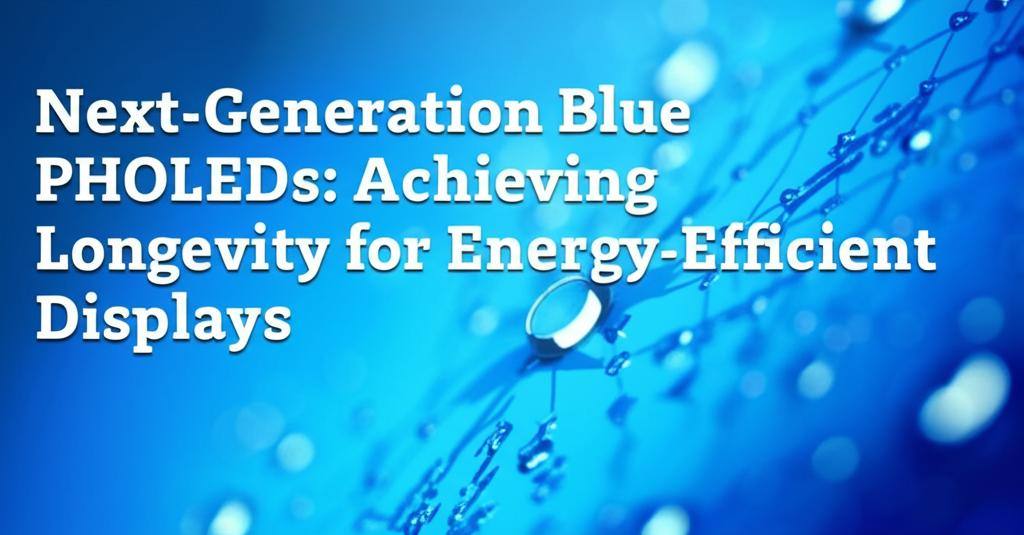The quest for vibrant, energy-efficient displays has long been hampered by a significant hurdle: the elusive, long-lasting blue phosphorescent organic light-emitting diode (PHOLED). While red and green PHOLEDs have achieved remarkable efficiency and stability, their blue counterpart has historically suffered from a shorter lifespan, hindering the overall performance and energy-saving potential of OLED technology. However, a wave of recent breakthroughs is finally turning the tide, heralding a new era for displays across our devices.
For over two decades, researchers and industry leaders have grappled with the inherent challenges of blue PHOLEDs. The higher energy of blue light tends to degrade the organic materials used in these displays more quickly than red or green emitters. This degradation leads to a shorter operational lifetime and a faster decline in brightness, an issue that has prevented the full realization of all-phosphorescent OLED displays, which promise nearly 100% internal quantum efficiency – meaning almost all electrical energy is converted into light. Current displays often work around this by using less efficient fluorescent blue emitters, which caps the overall energy savings.
The good news? The landscape is rapidly changing. Scientists are now cracking the code to durable blue PHOLEDs through innovative approaches in materials science and device architecture.
One exciting avenue involves the development of new iridium-based emitter materials. For instance, researchers in China have introduced novel emitters incorporating a bulky organic group called 3,6-di(tert-butyl)-9H-carbazolyl (tBuCz). This clever molecular design increases the space between molecules and spreads out the excited energy, significantly reducing the efficiency-killing and material-degrading processes that typically plague blue PHOLEDs at high brightness levels. These new emitters have demonstrated impressive results, including a photoluminescence quantum yield nearing the theoretical maximum and significantly extended operational lifetimes – one study reported an LT₅₀ (time to 50% brightness) of 1237 hours at a demanding 1000 cd/m² brightness.
Another game-changing strategy comes from researchers at the University of Michigan, who have focused on accelerating the light emission process itself. Their approach cleverly harnesses quantum mechanical phenomena. By creating an "exciton fast lane" using what are known as plasmon-exciton-polaritons (PEPs), they can speed up the conversion of electrical energy into blue light. This is achieved by adding a thin carbon-based semiconductor layer onto the electrode, which encourages the excited states (excitons) to resonate with surface plasmons (ripples in the electron sea on the metal surface) and emit photons more quickly. This rapid emission reduces the chances of destructive energy transfers that degrade the PHOLED materials.
Furthermore, this University of Michigan team has combined this "fast lane" concept with other structural innovations, such as tandem OLED structures (stacking two light-emitting layers to share the burden) and optical cavities that fine-tune the emitted blue light to a deeper, more desirable hue. The results are blue PHOLEDs that can now reportedly last as long and burn as bright as their highly efficient green counterparts. Some designs have shown the ability to maintain 90% of their blue light intensity for 10 to 14 times longer than previous deep blue designs.
The implications of these advancements are profound. Significantly longer-lasting and more efficient blue PHOLEDs pave the way for:
- More Energy-Efficient Devices: Displays that consume less power mean longer battery life for smartphones, tablets, and laptops, and reduced energy consumption for TVs and monitors. Estimates suggest that incorporating a blue PHOLED could reduce the power consumption of an AMOLED display by as much as 30%.
- Brighter and More Vibrant Displays: Enhanced efficiency can translate to brighter screens with improved color purity and accuracy, leading to a richer visual experience, especially in challenging lighting conditions or for demanding applications like augmented reality.
- Increased Device Lifespan: More durable displays mean fewer replacements, contributing to a reduction in electronic waste – a significant step towards more sustainable technology.
- The "Dream OLED": The commercial viability of stable and efficient blue PHOLEDs is the final piece of the puzzle for creating all-phosphorescent RGB (Red, Green, Blue) displays that offer the ultimate in efficiency and performance.
Major industry players are also making strides. LG Display, in partnership with Universal Display Corporation (UDC), recently announced the successful verification of commercialization-level performance for blue phosphorescent OLED panels on a mass production line. Their hybrid two-stack Tandem OLED structure, which combines blue fluorescence and phosphorescence, reportedly consumes about 15% less power while maintaining comparable stability to existing OLED panels.
While challenges such as material costs and the complexity of manufacturing these advanced PHOLED architectures still exist, the accelerated pace of innovation is undeniable. The journey to unlock the full potential of blue PHOLEDs has been long, but these recent breakthroughs signal that truly energy-efficient, vibrant, and long-lasting displays are no longer a distant dream but an impending reality, set to redefine our visual experience across a vast array of technologies.

